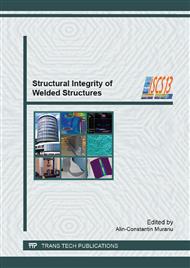p.1
p.7
p.19
p.25
p.33
p.41
p.49
p.54
Investigation of the Repair Welding Technology Using Ni Base Electrode
Abstract:
Metal materials are subjected to innumerable time-dependent degradation mechanisms when operate in power, petrochemical and refinery plant. These materials are subjected to multiaxial stresses, creep, fatigue, corrosion and abrasion. As a result of service especially at high temperatures and high pressures, can lead to forming cracks, damages or failures. In situation of breakdown in such systems there is a need for weld repair on plant components and repair work can be expensive and time-consuming. Most weld repairs of low alloy steels require high-temperature post weld heat treatment (PWHT); but in certain repairs, however, this is not always possible. Expenses of the repair work could be reduced if the weld repairing is performed on site. Application of the nickel based filler metal can be alternative to performing PWHT. These repair welding procedures with Ni based filler metal could be categorized as cold repair welding. Purpose of presented investigation was to compare a repair welding technology with filler austenite material based on Ni and without application of the PWHT, with a classical repair welding procedure with preheating and PWHT and using a filler metal with chemical composition similar to parent metal. Properties comparison of the welded joints obtained by these two repair welding technologies was performed for the Cr-Mo steel (13CrMo4-5) by the metal arc welding procedure with covered electrode (MMA - 111). Weldability analysis by the analytical equations and technological tests for determination of the sensitivity to crack forming for cold and hot cracks by the CTS and Y tests, were performed for both repair welding technologies. Tensile tests, absorbed energies tests, banding tests and hardness measurements were performed on trial joins. Light optical microscopy (LOM) was applied for microstructure analysis. The fracture toughness for both technologies, were estimated by the calculated stress intensity factor KIc and dynamic stress intensity factor KId for weld metal and heat affected zone. All of the obtained results were analyzed and discussed. It was concluded that repair welding technology with Ni base filler material without PWHT, enables welded joints without the appearance of cracks, with a good mechanical properties, slightly higher hardness in the HAZ, but with lower expenses compared to standard repair welding technology. In applying this technology in emergency welding repairing on-site, on the equipment and industrial facilities with high security requirements, inspection using non destructive technique has to be frequently applied compared to standard procedures.
Info:
Periodical:
Pages:
25-32
Citation:
Online since:
September 2013
Authors:
Keywords:
Price:
Сopyright:
© 2013 Trans Tech Publications Ltd. All Rights Reserved
Share:
Citation:


